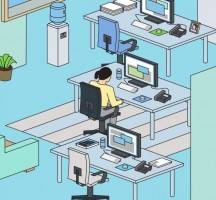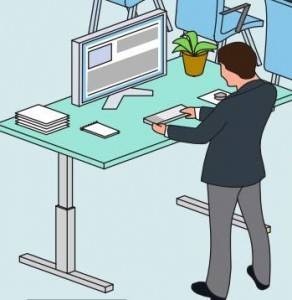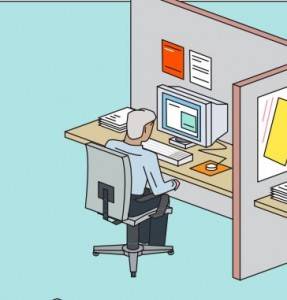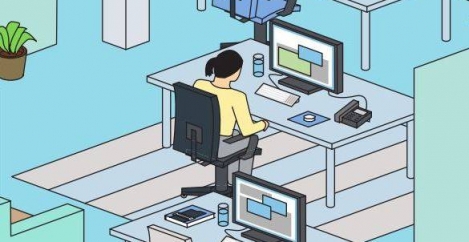July 13, 2016
Gensler publishes latest US and UK Workplace Surveys for 2016 0
 Gensler has announced the results of its Workplace Survey 2016 for both the UK and the US. Key claims of the UK report based on a study of 1,210 respondents include that the UK workforce seems to be divided into ‘haves and have-nots’, with mid and lower-tier workers confined to poor quality environments, 67 per cent of the workforce feel drained due to their office environment at the end of each day and that ‘innovators’ spend just 3.5 days of the working week in the office, highlighting the need for greater flexibility. Meanwhile, the key finding of the US study of 4,000 respondents is that a statistical link between the quality and functional make-up of the workplace and the level of innovation employees ascribe to their organisation, and found that a workplace that prioritises both individual and group work creates ‘an ecosystem of innovation’ across organisations and is a crucial predictor of how innovative an employee sees their company to be.
Gensler has announced the results of its Workplace Survey 2016 for both the UK and the US. Key claims of the UK report based on a study of 1,210 respondents include that the UK workforce seems to be divided into ‘haves and have-nots’, with mid and lower-tier workers confined to poor quality environments, 67 per cent of the workforce feel drained due to their office environment at the end of each day and that ‘innovators’ spend just 3.5 days of the working week in the office, highlighting the need for greater flexibility. Meanwhile, the key finding of the US study of 4,000 respondents is that a statistical link between the quality and functional make-up of the workplace and the level of innovation employees ascribe to their organisation, and found that a workplace that prioritises both individual and group work creates ‘an ecosystem of innovation’ across organisations and is a crucial predictor of how innovative an employee sees their company to be.
The UK
In the UK report, Gensler claims that badly designed open plan office environments are stifling innovation in businesses across the United Kingdom. Over 8 million UK employees work in open plan environments and many of these environments are not designed to promote creativity and innovation. The study indicates that overall the average workplace currently favours those in management positions, creating a generation of ‘haves and have-nots’.
According to the study, traditional open plan offices do not offer variety or choice, nor are they tailored to specific tasks and practices, with 70 per cent of employees forced to work in the same place throughout the day. The impact of this lack of choice is that only 33 per cent of respondents report feeling energised at the end of the day. Employees provided with a private office – usually the reserve of those in senior positions – rated their workplace environment the highest performing with those in management positions expressing greater job satisfaction and a sense of meaning.
 Innovators are five times more likely to have access to a private space and favour working alone. They spend less time in face-to-face collaboration and only 3.5 days of their working week in the office, compared with the other end of the spectrum who spend 86 per cent of their time desk-bound. They also actively choose to spend less time in their assigned spaces by making regular use of conference rooms and open plan meeting areas for collaboration when they are in the office.
Innovators are five times more likely to have access to a private space and favour working alone. They spend less time in face-to-face collaboration and only 3.5 days of their working week in the office, compared with the other end of the spectrum who spend 86 per cent of their time desk-bound. They also actively choose to spend less time in their assigned spaces by making regular use of conference rooms and open plan meeting areas for collaboration when they are in the office.
Survey respondents who scored highest for innovation achieved better productivity and effectiveness scores for all work modes – focus, collaboration, learning and socialising – and reported greater job satisfaction and a better relationship with their managers. The energy, pharmaceutical and creative industries are leading the way in workplace design by offering their employees the most choice.
Philip Tidd, Principal and Head of Consulting EMEA, Gensler, said: “Employees who scored lowest on innovation are one and a half times more likely to spend all day working in the same place and use their assigned desk for all manner of activities from intense concentration to team brainstorms. This is clearly not an effective use of space. Interestingly, enclosed office space is not the enemy and moving to a simplistic open plan may not be the most effective option in today’s hyper-connected workplace. Giving employees a greater variety of places and spaces along with the autonomy and choice to work when and where suits their task will boost innovation. Businesses should also think about matching space to need rather than hierarchy to engage employees of all levels of the organisation.”
Gensler’s four recommendations based on the results of the study are:
- Invest in your workplace and tailor space to the most important functions of your business to make open plan work environments more effective
- Diversify beyond the desk by including a variety of group work spaces inside and outside the office
- Empower the entire organisation, not just the senior leadership, to choose when and where they work
- Connect employees to their organisation and colleagues by adopting a workplace design strategy that supports their corporate purpose and sense of meaning
Philip Tidd continued: “A one size fits all approach is a fundamental mistake when it comes to workplace design. This holds true for a company’s approach to their own offices, but also to the notion of borrowing ideas or trends from other industry sectors – you need to do what is right for your particular business and the way your employees need to work. Getting the balance right will have a noticeable impact on the productivity, creativity and innovation of employees. Unfortunately, the gulf between the haves and have-nots appears quite dramatic. The ability to innovate is affected by the physical environment, so good workplace design is actually a way of getting ahead of the competition.”
The US
In a survey of more than 4,000 workers across 11 industries, Gensler, found that the most innovative companies provide their organisations with a diversity of well-designed spaces in which to collaborate and to focus, as well as empowering employees with the ability to work when and where best suits their work needs.
 “We are seeing that workplace design is a critical part of truly innovative companies’ success. On average, employees at innovative companies have better-designed, more functional workspaces that unlock creative potential,” says Diane Hoskins, co-CEO at Gensler. “Employees truly flourish when they have room to not only collaborate but also have space to focus, and are empowered to work when and how they work best—both within their workplace, and in other locations outside it.”
“We are seeing that workplace design is a critical part of truly innovative companies’ success. On average, employees at innovative companies have better-designed, more functional workspaces that unlock creative potential,” says Diane Hoskins, co-CEO at Gensler. “Employees truly flourish when they have room to not only collaborate but also have space to focus, and are empowered to work when and how they work best—both within their workplace, and in other locations outside it.”
Gensler’s 2016 US Workplace Survey data claims to provide a window into the workplaces of “top innovators” as measured by Gensler’s Innovation Index – an average of six tested and validated questions, focused on innovation, leadership, and creativity. Top innovators are determined by segmenting respondents into four groups based on their Innovation Index scores and identifying those employees ranking their companies as the most innovative in the sample. These are the top innovators, employees and organisations who are getting the workplace equation right. By comparing employees with the highest innovation index scores—those in the top quartile or 25 percent—to those in the bottom quartile, Gensler’s Survey identified a suite of behaviors and spatial attributes that markedly increase innovation.
According to the Gensler’s Workplace Survey, the most innovative employees have the option to work in a wide variety of spaces that meet their needs, and use that option to maximum effect – whether they need individual space to focus, a conference room to brainstorm or learn a new skill, or a social space to chat with co-workers during a coffee break.
Key findings on the habits of top innovators include:
- Innovators report spending only 74 percent of the work week at the office; less innovative employees spend 86 percent of time at the office
- Innovators are at least 2 times more likely to have access to, and use, cafeterias, coffee shops, and outdoor spaces
- Innovators report 2 times more access to amenities including specialty coffee, restaurants, gyms, and childcare facilities
- Innovators overall report 2 times more choice in when and where to work
Gensler’s 2016 U.S. Workplace Survey results account for organisations across industries, geographies and age groups – but solutions, Gensler says, must be company-specific. To inspire organisational innovation and optimise performance Gensler has developed a set of design action items every organisation can consider to optimise the workplace and improve performance and innovation:
- Invest in more functional workplaces and effectively managing those functions most important to individual performance to make any space type – even open office – highly effective.
- Diversify beyond the desk by including a variety of group work spaces inside and outside the workplace. Innovators have access to, and utilize a greater variety of spaces in and out of the office.
- Empower the entire organisational community, not just senior leadership, with the ability to choose when and where to work. From 2013 to 2016 choice at all levels of an organisation fell, but senior leadership continues to report greater choice than more professional or administrative staff.
- Connect every employee to the meaning behind their work, their company’s mission, and the broader organisational community with design strategies that support and impact corporate purpose.














